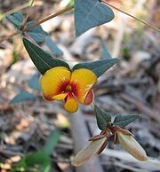
Platylobium obtusangulum
Encyclopedia
Platylobium obtusangulum (Common Flat-pea) is a shrub which is endemic to Australia
. It is a member of the family Fabaceae
and of the genus Platylobium
.
The species is an erect or straggling shrub that can grow up to 1 metre in height. The leaves are variable in shape and their length ranges from 1 to 3 cm.
The flowers appear in spring. These are yellow with a red centre and are supported by short pedicels that are concealed by a series of overlapping bracts. The pods which follow are 14 to 25 mm in length and 10 to 14 mm in width.
The species was first formally described by botanist William Jackson Hooker
in 1833 in Botanical Magazine. There are currently two recognised varieties:
This species is found in South Australia
, Tasmania
, and Victoria
.
Australia
Australia , officially the Commonwealth of Australia, is a country in the Southern Hemisphere comprising the mainland of the Australian continent, the island of Tasmania, and numerous smaller islands in the Indian and Pacific Oceans. It is the world's sixth-largest country by total area...
. It is a member of the family Fabaceae
Fabaceae
The Fabaceae or Leguminosae, commonly known as the legume, pea, or bean family, is a large and economically important family of flowering plants. The group is the third largest land plant family, behind only the Orchidaceae and Asteraceae, with 730 genera and over 19,400 species...
and of the genus Platylobium
Platylobium
Platylobium is a genus of shrubs in the Fabaceae family. Native to south eastern Australia, they occur in a range of habitats of the coastal regions. The genus was first described by James Edward Smith, and is closely allied to another genera within the bossiaeeae grouping, Bossiaea.The plants...
.
The species is an erect or straggling shrub that can grow up to 1 metre in height. The leaves are variable in shape and their length ranges from 1 to 3 cm.
The flowers appear in spring. These are yellow with a red centre and are supported by short pedicels that are concealed by a series of overlapping bracts. The pods which follow are 14 to 25 mm in length and 10 to 14 mm in width.
The species was first formally described by botanist William Jackson Hooker
William Jackson Hooker
Sir William Jackson Hooker, FRS was an English systematic botanist and organiser. He held the post of Regius Professor of Botany at Glasgow University, and was the first Director of the Royal Botanic Gardens, Kew. He enjoyed the friendship and support of Sir Joseph Banks for his exploring,...
in 1833 in Botanical Magazine. There are currently two recognised varieties:
- P. obtusangulum Hook. var. obtusangulum
- P. obtusangulum var. spinulosum J.H.Willis
This species is found in South Australia
South Australia
South Australia is a state of Australia in the southern central part of the country. It covers some of the most arid parts of the continent; with a total land area of , it is the fourth largest of Australia's six states and two territories.South Australia shares borders with all of the mainland...
, Tasmania
Tasmania
Tasmania is an Australian island and state. It is south of the continent, separated by Bass Strait. The state includes the island of Tasmania—the 26th largest island in the world—and the surrounding islands. The state has a population of 507,626 , of whom almost half reside in the greater Hobart...
, and Victoria
Victoria (Australia)
Victoria is the second most populous state in Australia. Geographically the smallest mainland state, Victoria is bordered by New South Wales, South Australia, and Tasmania on Boundary Islet to the north, west and south respectively....
.

